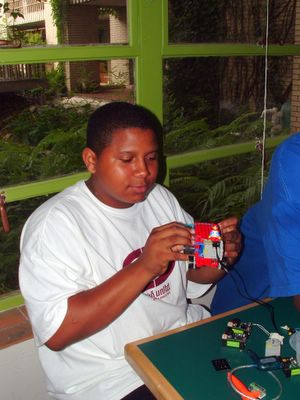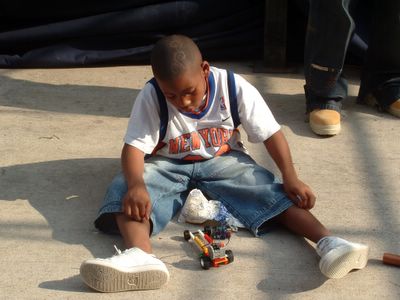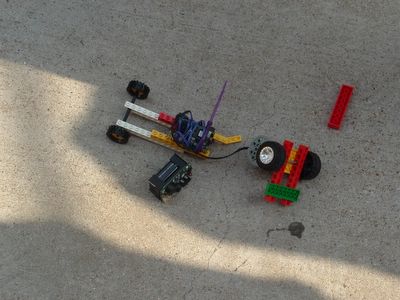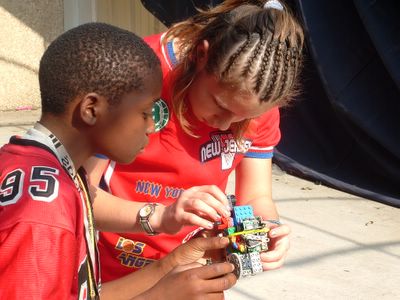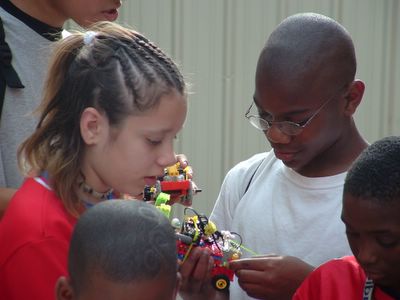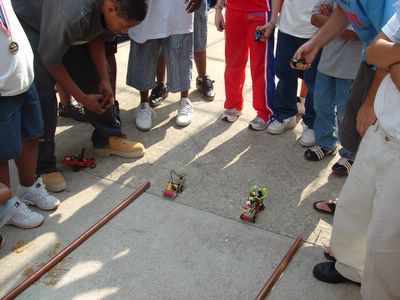In like a lion, out like a lamb. This was quite an accurate description for the month of May for DesignIT at Panther and our last cycle of the school year. And although we almost got eaten from frustration the first few activities, things smoothed out and finished with a fun and memeorable last day at the club of our 04'-05' school year. Here's the laydown of our last cycle entitled "intro to I.R."...
Coming back from a day of illness, on May 4th I referred back to our "pie ideas" website and put together an activity a few of the kids wanted to try entitled "cup guitars". I'm not going to spend much time on this story, but simply ask that you, the reader, learn from my mistakes. Simply put, I gathered and bought all the right supplies just in time to leave for the club before being able to attempt the activity myself. The afternoon looked promising, and the kids (about 6 of them), Gabe and I all followed step by step instructions together to build our inventions, which I'm afraid they didn't work. So we taught the kids a little about trouble-shooting and problem solving, but alas, they still did not work. So ended up taking apart 0.99$ earphones the rest of the time, which actually was not a bad substitute activity, but we did lose a few that were interested earlier than I'd anticipated. So a simple lesson, attempt the activity yourself before teaching it.
On Monday Saafir and I decided it was time for us and the kids to finally unvail the I.R. (infa-red) technology our little cricket friends possess. But since I would be at the club that day, we decided it would be best to wow them with a neat I.R. trick, then bring them to the museum to teach the actual programming. The program Saafir came up with was quite a complicated one where a group of ten crickets facing eachother beeped a certain random pitch with a value between 1 and 250 every second. Then, as they beeped, they were able read the crickets next to them, and lower or raise thier own pitch until all ten were on beeping the same note in unison. This made them truely sound like crickets, the insects, and truely memorizing.
Because the crickets had displays on them, we eventually created a game where we closed our eyes and tried to guess the moment all the crickets chirped in unison. When someone predicted it, we opened our eyes to check the numbers on the displays to see if they were right. Kind of an ear-training excersize of sorts. If attempting this game, it may work better to program the crickets to beep less frequently, like say every 5 seconds in stead of 1.
While kids played, Gabe and I brainstormed together about how we could take this complex program down to a teachable activity or two to get the kids started. That day we had a couple epiphanies on how to do so, and these ideas and thier results will be desribed below under the activity "Intro to I.R.".
After we played the game, and before the kids could wander off, I handed out a "talking cricket questionaire" for each teen to fill out. As incentive, I warned them that this was thier ticket for the van if they wanted to attend our museum field trip on Wednesday. It worked, and the answers I got from the questions ranged from accurate to hysterical. Some examples...
Q: How do you think crickets, the insects, talk to one another?A: ChirpingA: With their legs
A: Yes
Q: How do you think our crickets, the machines, talk to one another?A: The computerA: With the lights
A: With the wires
Q: What is a wave?A: ?A: (drawing of a squiggly line)
Q: Name 5 differant kinds of waves...A: Sound
A: Radio
A: Ocean
A: Phone
A: Hello and Goodbye
Q: What do you think the "I.R." in "I.R. waves" stands for?A: Inter Radio?A: I Ron't know.
So, with questionaires answered, and curiousity sparked, on Wednesday, May 11th, eight girls from Panther hopped in the van to head to the museum. When they arrived I had a long table set up with enough computers for groups of two to share and the digital projector showing a program from my computer. Before we opened the computers, we went over the answer of the "talking cricket questionaire". To keep them focused, I called on one of them to read a question, and she, the reader, got to choose who would answer. If they answered it right, they read next, and so on.
After the discussion, we moved onto our first I.R. session...
Activity 1: "Intro to I.R."
Big Idea: Educating kids on how to program I.R. programs.
Dates:Wednesday, May 11th
Groups Participating: panther boys and girls club kids
Attendance: 8 kids and Gabe and I
Materials: Software: laptops, transfer cables, transfer crickets, 3 crickets at each laptop
Hardware: hand held mirrors
Directions: Two activities.
Activity one: Through basic I.R. program displayed by the digital projector, have the kids program one of thier crickets to be "remote" and program the other cricket to be "reciever", where the program has the remote send a "beep" command to the reciever every second. Then have the kids block the signal between the remote and the reciever with objects, themselves, and test the farthest distance that they can read eachother. Also introduce mirrors and have them experiment with reflection.
Activity two: Have the kids reprogram "remote" cricket to send a random value between 1 and 250 every second. Next program one "reciever" cricket to only beep when the sent values of 1 to 125 are sent, and a second reciever cricket to only beep the sent values of 126 and 250 are sent. Have the kids notice they never beep at the same time.
Skills: I.R. programming, understanding how I.R. waves are sent and work, understanding of how the crickets communicate
Associated Concepts: confidence in programming, working in pairs premotes cooperation
Best Part: Success when beepin begins. Also, we may want to consider some activities be divided occasionally by the sexes. It was extremely progressive that day, and that may have something to do with it.
Worst Part: Goin home! We made great progress that day.
Culminating Event: (leads to)2005 Nasc-I.R. races at Panther Courtyard Speedway
Improvements: Have ALL designIT kids check out these intro excersizes cause they work!
The following Monday, May 16th, these 8 girls, armed with the of knowing how to program I.R., had the opportunity to win a candy bar if they recruited someone who was not present on the previous Wednesday and tought that one person what we learned without touching the keyboard. We had the digital projector going for guidence again, and I gave away 10 candy bars that day, so 5 more learned the basics. Not too shabby.
I gotta go to work, so next time I'll finish up our last three sessions, with the building and programming of our nasc-I.R.'s, and the big race. And finally I'll get some photos and films posted as well.
Myles Hayes
